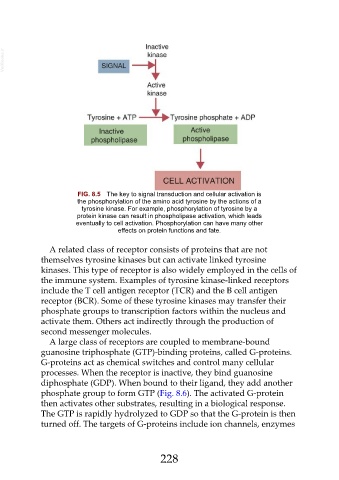Page 228 - Veterinary Immunology, 10th Edition
P. 228
VetBooks.ir
FIG. 8.5 The key to signal transduction and cellular activation is
the phosphorylation of the amino acid tyrosine by the actions of a
tyrosine kinase. For example, phosphorylation of tyrosine by a
protein kinase can result in phospholipase activation, which leads
eventually to cell activation. Phosphorylation can have many other
effects on protein functions and fate.
A related class of receptor consists of proteins that are not
themselves tyrosine kinases but can activate linked tyrosine
kinases. This type of receptor is also widely employed in the cells of
the immune system. Examples of tyrosine kinase-linked receptors
include the T cell antigen receptor (TCR) and the B cell antigen
receptor (BCR). Some of these tyrosine kinases may transfer their
phosphate groups to transcription factors within the nucleus and
activate them. Others act indirectly through the production of
second messenger molecules.
A large class of receptors are coupled to membrane-bound
guanosine triphosphate (GTP)-binding proteins, called G-proteins.
G-proteins act as chemical switches and control many cellular
processes. When the receptor is inactive, they bind guanosine
diphosphate (GDP). When bound to their ligand, they add another
phosphate group to form GTP (Fig. 8.6). The activated G-protein
then activates other substrates, resulting in a biological response.
The GTP is rapidly hydrolyzed to GDP so that the G-protein is then
turned off. The targets of G-proteins include ion channels, enzymes
228

